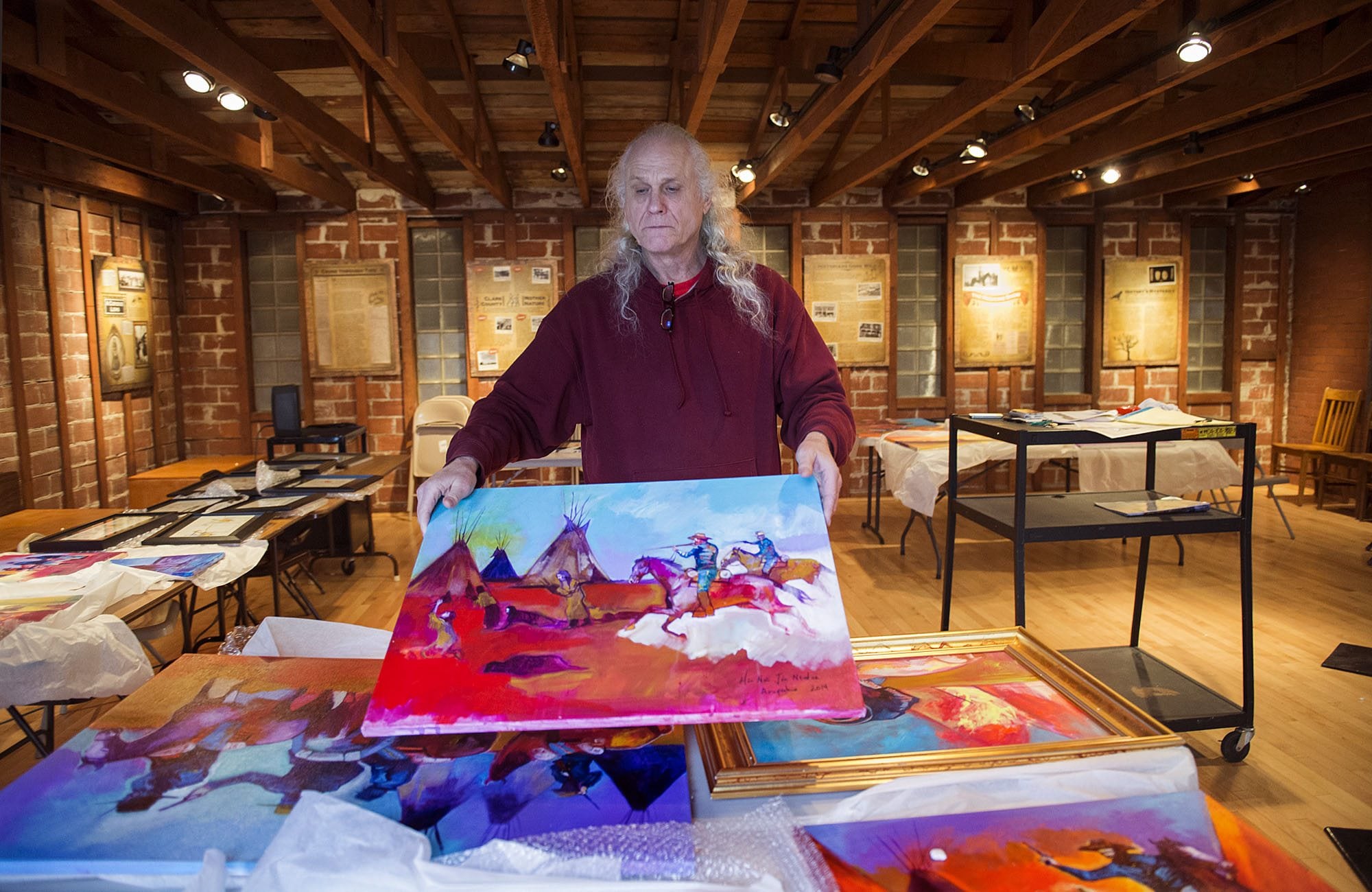Roben White had a rough time unpacking and examining the traveling art exhibit that’s now up on the walls of the Clark County Historical Museum’s center gallery.
White, a dedicated museum volunteer, is a descendant of survivors of the Sand Creek Massacre, an atrocity that occurred in southeastern Colorado in November 1864. Seven hundred cavalrymen under the command of U.S. Army Col. John Chivington waited until the Cheyenne and Arapaho men had left their village to go hunting for the day; then they attacked without mercy, killing and mutilating about 200 — about two-thirds of them women and children.
The members of the Cheyenne and Arapaho tribes had been awaiting a promised peace delegation for a month before the attack. Chivington later paraded body parts of the massacre victims through the streets of Denver.
“It was pretty much the policy to exterminate them,” White said. “They did things you wouldn’t imagine a human being doing to another human being.” A couple of officers refused to attack, White said, and they supplied eyewitness evidence of what happened at Sand Creek. “It was determined to be murder and genocide, but nothing was ever done,” White said.
Schedule, prices: One November Morning
4 to 7 p.m. Saturday: Exhibition opening and program by Brent Learned and George Curtis Levi (free with admission).
Noon to 8 p.m. Monday: Native social day exclusively for the Native American community (admission waived).
Feb. 17: Mural painting by Learned and Levi (details to be announced).
6 to 8 p.m. Feb. 19: Repeat opening program by Learned and Levi ($15).
11 a.m. to 4 p.m. Feb. 20: Social and workshop with Learned Levi (free with admission).
More than a century and a half later, White said, the tragedy still reverberates for himself and his family. “The suffering goes through generations,” he said. Sand Creek was a milestone in the overall displacement and destruction of tribal nations as the growing United States chased across the West after resources such as land and gold, he said; modern American Indians like himself are constantly urged to “get over it” and integrate into mainstream white society — while also feeling a profound need to somehow preserve and rebuild their own wounded culture.
The outcome of Sand Creek “affects me on a daily basis,” he said. “We’re still trying to repair our culture and our spiritual values.”
Horrible history
Soldiers stand by while a cannon blasts white-hot light at a group of tipis. A soldier on a horse raises a club over a woman trying to shield her child. A soldier throws some sort of mangled, bloody carcass over his shoulder. And another soldier bows his head and covers his eyes — maybe to block out the carnage. Unless he’s just tired after a long day of violence.
Those bold, saturated paintings by Brent Learned are the bulk of the 30-piece exhibit depicting the Sand Creek Massacre called “One November Morning.” There’s also “ledger art” by George Levi — sketches and illustrations in the style of his 19th century ancestors, frequently prisoners who switched to lined-paper notebooks after the buffalo skins they had used for artwork and storytelling became scarce. And, there will also be more contemporary-feeling paintings by B.J. Stepp.
All three artists are from Oklahoma, where so many native nations were eventually driven. Learned and Levi will both visit our area to spend nine days leading special programs, video presentations and discussions about the exhibit, starting at 4 p.m. Feb. 13 at the museum. The artists will also make presentations at Clark College, the Fort Vancouver National Historic Site, Washington State University Vancouver and the Portland Art Museum — but if you want to view their original artworks, the Clark County Historical Museum is where you must go.
That’s a coup for museum director Katie Anderson, who has been working to emphasize American Indian history at the museum since she came here in 2014.
“I love the idea of using art to tell about history,” said Anderson. She said she learned about the traveling exhibit when it was in Chicago and discovered that there were gaps in its schedule. She swooped in and managed to book “One November Morning” for what turned out to be its debut on the West Coast.
The artists will show a 35-minute video as part of their presentation, which they’ll offer twice, on Feb. 13 and again on Feb. 19. And, they plan to create some sort of original mural on Feb. 17; details are still forthcoming but spectators should be able to watch them work, Anderson said.
If You Go: One November Morning
What: “One November Morning” art show, presentations by descendants of survivors of the Sand Creek, Colo., massacre of 1864.
Where: Clark County Historical Museum, 1511 Main St., Vancouver.
Admission: $4 for adults, $3 for students and seniors.
On the web: www.cchmuseum.org/one-november-morning
What happened at Sand Creek is not well-known, White and Anderson both said, but it was a major event for tribes that never really recovered but did seek bloody revenge, accelerating all-out war between whites and native nations in the West. And it remains controversial today; the site used to be marked with a monument that called it a “battleground,” but the latter word was eventually replaced with “massacre.”
The monument still gets vandalized by folks who object to that word, Anderson said. Meanwhile, in 2014, the governor of Colorado formally apologized to descendants of survivors.
“It’s still tender today but this is a story we need to be aware of,” Anderson said. “We do anticipate that some people will get emotional.”




